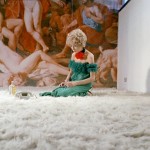Dir. by Rainer Werner Fassbinder
Images: Staged entirely in Petra’s bedroom and filmed largely in long takes, using slow tracking and deep focus shots. Mise-en-scene might be described as early-70s, too-hip opulence: bright colors, shag carpets, cutting edge (but impractical and uncomfortable) fashions. Characters are often dwarfed by a Michelangelo-esque wall mural, which is particularly interesting when the nude male figures can be seen (often only from the waist down) between the faces of the actresses. The film “feels” like a play — broken into several (6?) scenes, each clearly delineated by a fade-out/fade-in.
• • •
The title character (played by Margit Carstensen) is a successful fashion designer whose happiness has been shattered by the death of her first husband and by a bitter divorce from her second. Her sad existence is reflected by the mise-en-scene: isolated (there are no windows), grotesquely fashionable, and charged with ambivalent sexuality (her bed is the only practical furniture). After relating to a friend the shameful details of her failed marriage, Petra is introduced to Karin (Hanna Schygulla), a beautiful young woman who apparently shares Petra’s bitterness with life and love. The two become lovers, living together for six months until Karin finds success as a model and returns to her husband.
Petra’s “bitterness” is more likely the frustration of a woman incapable of selfless behavior. She brutally dominates those close to her — including her mother, her daughter, and her silent servant, Marlene — as if she were a spoiled child. When Karin leaves her, for instance, Petra explodes into a gin-fueled tantrum, shattering her tea set and literally rolling on the floor, beating her fists. Petra is a tragic figure, beautifully realized by Carstensen and Fassbinder. With each scene, she slips into a new character, as if a new wig, a new outfit might offer the cure she seeks. She’s at her most honest and sympathetic, though, in the film’s opening and closing scenes, when we find her lying alone in bed without a wig or make-up.
Perhaps the most interesting character in The Bitter Tears of Petra von Kant is Marlene, the silent and endlessly accommodating servant. She adds to the film yet another layer of strange sexual politics. (With her tight black dresses and straight-backed walk, I couldn’t help but be reminded of that oft-cited lesbian film icon, Miss Danvers from Hitchcock’s Rebecca.) But Marlene is different from the other women in Petra’s life in her refusal to be dominated. Their relationship, though clearly marked as master/servant, is also clearly founded on Marlene’s terms. When, at the end of the film, Petra attempts to lift Marlene onto an equal plane, Marlene refuses, choosing to remain silent and to leave.
Fassbinder’s experience in the theater is obvious here. In fact, I can think of few cinematic precedents for this film, but was reminded throughout of plays like Maria Irene Fornes’ Fefu and Her Friends, another experimental examination of heterosexual frustrations and repressed lesbian desire that also features an all female cast. Also, the constant tapping of Marlene’s typewriter feels like a direct allusion to Sophie Treadwell’s Machinal, a wonderful piece of early-20th century expressionism.

Comments
One response to “The Bitter Tears of Petra Van Kant (1972)”
“The Bitter Tears of Petra von Kant” by Rainer Werner Fassbinder
Is a film-intellectual stylization in which sexual exoticism and melodramatic accent serve as vehicles for Fassbinder’s elaborate analysis of today’s culturally elitist sensibility. The very style of cinematic narration reflects affectation of the film’s characters (when sincerity and pretense don’t contradict one another but unite in the art of spontaneous creativity). Fassbinder’s narrative style is semantically dense to an exceptional degree as his tool for the probing the characters’ psychology and the content and plot of the film. The film is a romantic parody, a work of art that analyzes its own love toward the world we live in today, love in spite of everything. It is a confession in being tremendously attracted to what can be called a modernity in human emotions, but Fassbinder’s melting attraction to it is going together with his ascetic effort to comprehend and to criticize what is so irresistible in today’s human beings with an intellectual calling. Petra von Kant is the best of us, and she is also an alerting sign of danger that the charm of democratic modernity carries inside. The analysis of the very mechanism of the aestheticism of living and feeling is not an easy adventure. Fassbinder mobilizes his scholarly powers to penetrate the aesthetic charms of the main protagonist and her reasoning about life. The predatoriness he finds in the very depth of democratic worldview is, no question, more veiled and even beautified than in pre-democratic behavioral style and in today’s neo-conservative demarches, but simultaneously it is more insidious and more seductive. This film is a necessary gift to anyone with an aesthetic sensitivity and the need to think what is behind the surface of life. It is about the human intellectual power (personified by the director’s thinking in and through the cinematic visuality) deployed against the beauty of the film’s images, and it is about the beauty of the intellectual power deployed against the defensive structures which the minds of the protagonists create to confuse and to entertain themselves and one another. Please, visit: http://www.actingoutpolitics.com to read about films by Godard, Resnais, Bergman, Pasolini, Cavani, Alain Tanner, Kurosawa, Bresson, Antonioni, Fassbinder, Herzog and Schlondorff (with analysis of shots) By Victor Enyutin